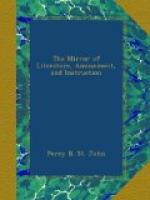Such a town would hardly have known what to do with a highly informed and educated surgeon, such as one now generally sees in that most liberal profession. My friend, John Hallett, suited it exactly. His predecessor, Mr. Simon Saunders, had been a small, wrinkled, spare old gentleman, with a short cough and a thin voice, who always seemed as if he needed an apothecary himself. He wore generally a full suit of drab, a flaxen wig of the sort called a Bob Jerom, and a very tight muslin stock; a costume which he had adopted in his younger days in imitation of the most eminent physician of the next city, and continued to the time of his death. Perhaps the cough might have been originally an imitation also, ingrafted on the system by habit. It had a most unsatisfactory sound, and seemed more like a trick than a real effort of nature. His talk was civil, prosy, and fidgetty: much addicted to small scandal, and that kind of news which passes under the denomination of tittle-tattle, he was sure to tell one half of the town where the other drank tea, and recollected the blancmanges and jellies on a supper-table, or described a new gown, with as much science and unction as if he had been used to make jellies and wear gowns in his own person. Certain professional peculiarities might have favoured the supposition. His mode of practice was exactly that popularly attributed to old women. He delighted in innocent remedies—manna, magnesia, and camphor julep; never put on a blister in his life; and would sooner, from pure complaisance, let a patient die, than administer an unpalatable prescription.
So qualified, to say nothing of his gifts in tea-drinking, cassino, and quadrille (whist was too many for him), his popularity could not be questioned. When he expired, all Hazelby mourned. The lamentation was general. The women of every degree (to borrow a phrase from that great phrase-monger, Horace Walpole) “cried quarts;” and the procession to the churchyard—that very churchyard to which he had himself attended so many of his patients—was now followed by all of them that remained alive.
It was felt that the successor of Mr. Simon Saunders would have many difficulties to encounter. My friend, John Hallett, “came, and saw, and overcame.” John was what is usually called a rough diamond. Imagine a short, clumsy, stout-built figure, almost as broad as it is long, crowned by a bullet head, covered with shaggy brown hair, sticking out in every direction; the face round and solid, with a complexion originally fair, but dyed one red by exposure to all sorts of weather; open good-humoured eyes, of a greenish cast, his admirers called them hazel; a wide mouth, full of large white teeth; a cocked-up nose, and a double chin; bearing altogether a strong resemblance to a print which I once saw hanging up in an alehouse parlour, of “the celebrated divine (to use the identical words of the legend) Dr. Martin Luther.”




